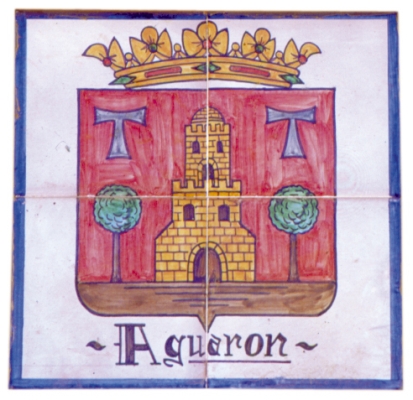
Heritage, culture and traditions
HERITAGE
TOWN HALL
LOCATION: Calle Mayor, 1
CHRONOLOGY: 18th century
GENERAL DESCRIPTION:
The building was built in the 18th century, in line with the neoclassical art emergent those years in the Iberian Peninsula.
Its key features are three arches that give way to its spacious market or almudí.
According to the description made by Pascual Madoz, between 1845 and 1850: “The town hall is spacious and we built with a market, three elegant arches that make up the first floor, the façade is also of excellent taste, with eaves that were made following the ancient tradition…”
Nowadays, it presents a similar aspect to the description of Pascual Madoz.
The entrance is under three arches, there is a second floor divided in two, a feature that can be seen thanks to the balcony with three windows and on top lintel openings of lesser length. Finally, appears one last body with lintel openings even smaller than the other.
There is a good sized wooden eave at the top of the façade.
SAN MIGUEL ARCÁNGEL PARISH CHURCH
LOCATION: In the center of the town
CRONOLOGY: 18th century
GENERAL DESCRIPTION:
The parish church of Aguarón is located in the center of the town and due to its size can be seen in nearly every panoramic view in the town. This temple was inaugurated in 1770 and therefore has a baroque style, even though around that period of time, this art already started to decline.
The floor plan is made up of three naves and a transept covered with a semi-spherical dome, supported by four pedentives and a drum, represented by colored tiles and a lantern as its keystone.
Undoubtedly, when visiting the church the most stunning thing is a monumental façade, the front and the end are flanked by two high towers. All this façade, except from the foundation stone, was made in brick, the most commonly used material in the area and continuing a mudejar tradition typical from this territory.
The external appearance deserves specific attention, but so does the interior, where many altarpieces belonging to different centuries (16th, 17th and 18th) can be observed and especially inside the monument, where interesting sculptures remain from the Renaissance period as well as a magnificent organ.
SAN CRISTÓBAL HERMITAGE
LOCATION: located on the “El santo” site in the middle of Sierra de Algairén, a privileged place to observe magnificent views of Cariñena’s lands.
ACCESS DESCRIPTION: it is 3 kilometers from Aguarón. Once in the town, take the road to Codos, where you’ll find a turning to the right which indicates: “Ermita de San Cristóbal”
CRONOLOGY: 16th century
GENERAL DESCRIPTION:
This hermitage, modest in size, is made up of a small gothic building covered with wood over pointed arches. Over time it has undergone several changes, thus modifying its initial style. Inside the building there are two wooden altarpieces from the 16th century. One is dedicated to the Assumption of Mary and the other to Our Lady of the Rosary. Reliefs of the fifteen mysteries are made in wood while figures are round shaped. The most ancient image is from the 13th century and represents the Virgin together with the Child, Romanic from the 12th century.
NUESTRA SEÑORA DEL ROSARIO CHURCH
CHURCH: Nuestra Señora del Rosario
CRONOLOGY: Between the 14th and 17th centuries
LOCATION: It is located in the center of the town
GENERAL DESCRIPTION:
The current temple substituted a different one from between the 12th century – first part of 14th century. In the part of the apse a lot of its original work is preserved with ashlar stone walls that make a five-sided presbytery with buttresses.
Two hollows with a pointed arched typical from Gothic architecture in the first half of the 14th century can also be found.
The rest of the building has been refurbished in different periods. During the first half of the 14th century, two hermitages were created on the sides of the presbytery, vaulted with star motifs, and some side hermitages of the single nave belonging to the 16th century, divided into four sections.
On the left side there is a hermitage covered with a dome with six sides of Múdejar plasterwork.
In its interior there are small chapels between buttresses, a nave with a five-sided apse and marble floor as well.
Vault-covered in star motifs, decorated with beautiful keystones.
CULTURE AND TRADITION IN AGUARÓN
The Municipal Band
“A great musical tradition of Aguarón”
This Band was founded in 1848 by Mr. Julián Costa who was the first manager. Throughout the last 150 years of continuous operation, the band has had 11 managers of which 8 were originally members before taking the position.
It is estimated that more than 250 musicians studied and were part of it, and more than 300 towns of the whole Spanish geography have welcomed this band. The band has participated in the local festivities of towns such as Alhama de Aragón or Bronchales for more than 80 and 25 years respectively. We cannot forget the actual village of Aguarón, livened up by them practically since the band was founded.
Some outstanding performances were: Teruel (First Prize in 1919), Calatayud (First Prize in 1925), International Exposition of Barcelona (1929) as representative from Aragón, Zaragoza (Third Prize in 1983 and Second Prize in 1985), as well as many other awarded prizes through its history. When Mr. Ángel Gimeno was the mayor in 1983, a square was built in his honor as a way of recognizing his merits and dedication to Aguarón.
HOSTEL
LOCAL HOSTELS OF AGUARÓN +34 976 620 383